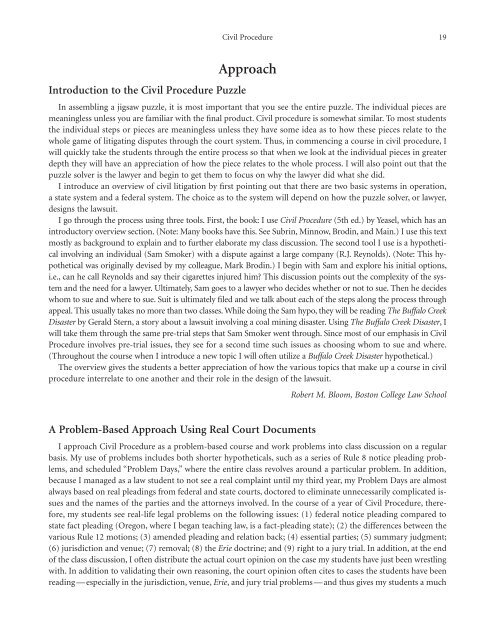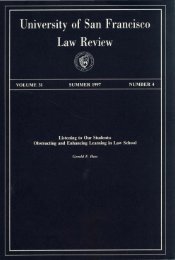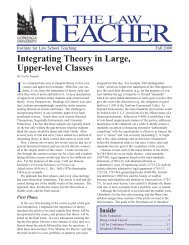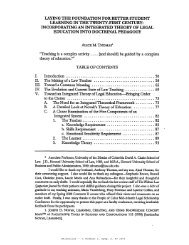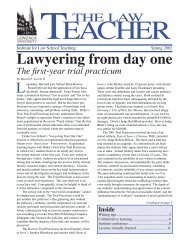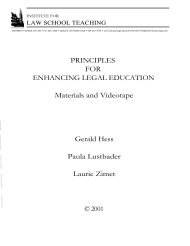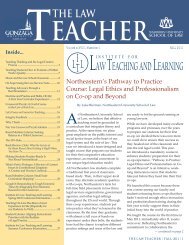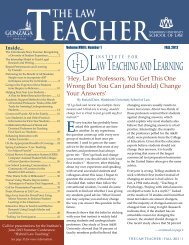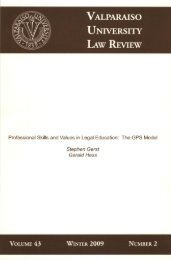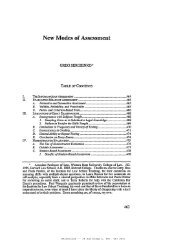Teaching the Law School Curriculum - Institute for Law Teaching ...
Teaching the Law School Curriculum - Institute for Law Teaching ...
Teaching the Law School Curriculum - Institute for Law Teaching ...
Create successful ePaper yourself
Turn your PDF publications into a flip-book with our unique Google optimized e-Paper software.
Introduction to <strong>the</strong> Civil Procedure Puzzle<br />
Civil Procedure 19<br />
Approach<br />
In assembling a jigsaw puzzle, it is most important that you see <strong>the</strong> entire puzzle. The individual pieces are<br />
meaningless unless you are familiar with <strong>the</strong> final product. Civil procedure is somewhat similar. To most students<br />
<strong>the</strong> individual steps or pieces are meaningless unless <strong>the</strong>y have some idea as to how <strong>the</strong>se pieces relate to <strong>the</strong><br />
whole game of litigating disputes through <strong>the</strong> court system. Thus, in commencing a course in civil procedure, I<br />
will quickly take <strong>the</strong> students through <strong>the</strong> entire process so that when we look at <strong>the</strong> individual pieces in greater<br />
depth <strong>the</strong>y will have an appreciation of how <strong>the</strong> piece relates to <strong>the</strong> whole process. I will also point out that <strong>the</strong><br />
puzzle solver is <strong>the</strong> lawyer and begin to get <strong>the</strong>m to focus on why <strong>the</strong> lawyer did what she did.<br />
I introduce an overview of civil litigation by first pointing out that <strong>the</strong>re are two basic systems in operation,<br />
a state system and a federal system. The choice as to <strong>the</strong> system will depend on how <strong>the</strong> puzzle solver, or lawyer,<br />
designs <strong>the</strong> lawsuit.<br />
I go through <strong>the</strong> process using three tools. First, <strong>the</strong> book: I use Civil Procedure (5th ed.) by Yeasel, which has an<br />
introductory overview section. (Note: Many books have this. See Subrin, Minnow, Brodin, and Main.) I use this text<br />
mostly as background to explain and to fur<strong>the</strong>r elaborate my class discussion. The second tool I use is a hypo<strong>the</strong>tical<br />
involving an individual (Sam Smoker) with a dispute against a large company (R.J. Reynolds). (Note: This hypo<strong>the</strong>tical<br />
was originally devised by my colleague, Mark Brodin.) I begin with Sam and explore his initial options,<br />
i.e., can he call Reynolds and say <strong>the</strong>ir cigarettes injured him? This discussion points out <strong>the</strong> complexity of <strong>the</strong> system<br />
and <strong>the</strong> need <strong>for</strong> a lawyer. Ultimately, Sam goes to a lawyer who decides whe<strong>the</strong>r or not to sue. Then he decides<br />
whom to sue and where to sue. Suit is ultimately filed and we talk about each of <strong>the</strong> steps along <strong>the</strong> process through<br />
appeal. This usually takes no more than two classes. While doing <strong>the</strong> Sam hypo, <strong>the</strong>y will be reading The Buffalo Creek<br />
Disaster by Gerald Stern, a story about a lawsuit involving a coal mining disaster. Using The Buffalo Creek Disaster, I<br />
will take <strong>the</strong>m through <strong>the</strong> same pre-trial steps that Sam Smoker went through. Since most of our emphasis in Civil<br />
Procedure involves pre-trial issues, <strong>the</strong>y see <strong>for</strong> a second time such issues as choosing whom to sue and where.<br />
(Throughout <strong>the</strong> course when I introduce a new topic I will often utilize a Buffalo Creek Disaster hypo<strong>the</strong>tical.)<br />
The overview gives <strong>the</strong> students a better appreciation of how <strong>the</strong> various topics that make up a course in civil<br />
procedure interrelate to one ano<strong>the</strong>r and <strong>the</strong>ir role in <strong>the</strong> design of <strong>the</strong> lawsuit.<br />
A Problem-Based Approach Using Real Court Documents<br />
Robert M. Bloom, Boston College <strong>Law</strong> <strong>School</strong><br />
I approach Civil Procedure as a problem-based course and work problems into class discussion on a regular<br />
basis. My use of problems includes both shorter hypo<strong>the</strong>ticals, such as a series of Rule 8 notice pleading problems,<br />
and scheduled “Problem Days,” where <strong>the</strong> entire class revolves around a particular problem. In addition,<br />
because I managed as a law student to not see a real complaint until my third year, my Problem Days are almost<br />
always based on real pleadings from federal and state courts, doctored to eliminate unnecessarily complicated issues<br />
and <strong>the</strong> names of <strong>the</strong> parties and <strong>the</strong> attorneys involved. In <strong>the</strong> course of a year of Civil Procedure, <strong>the</strong>re<strong>for</strong>e,<br />
my students see real-life legal problems on <strong>the</strong> following issues: (1) federal notice pleading compared to<br />
state fact pleading (Oregon, where I began teaching law, is a fact-pleading state); (2) <strong>the</strong> differences between <strong>the</strong><br />
various Rule 12 motions; (3) amended pleading and relation back; (4) essential parties; (5) summary judgment;<br />
(6) jurisdiction and venue; (7) removal; (8) <strong>the</strong> Erie doctrine; and (9) right to a jury trial. In addition, at <strong>the</strong> end<br />
of <strong>the</strong> class discussion, I often distribute <strong>the</strong> actual court opinion on <strong>the</strong> case my students have just been wrestling<br />
with. In addition to validating <strong>the</strong>ir own reasoning, <strong>the</strong> court opinion often cites to cases <strong>the</strong> students have been<br />
reading — especially in <strong>the</strong> jurisdiction, venue, Erie, and jury trial problems — and thus gives my students a much


